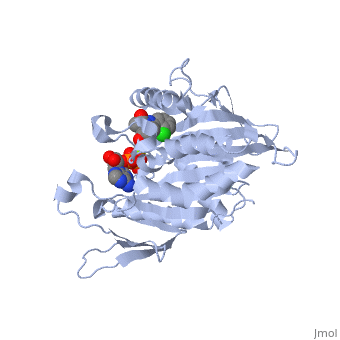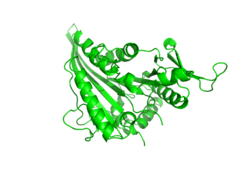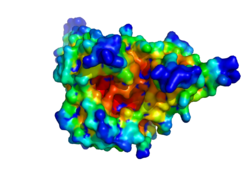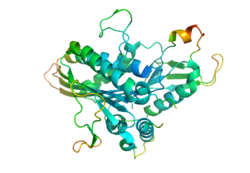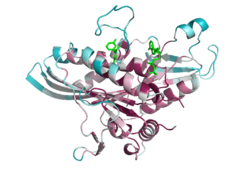Kinesin-5
From Proteopedia
| |||||||||
| Kinesin-5 complex with inhibitor, ADP and Mg+2 ion, 1yrs | |||||||||
|---|---|---|---|---|---|---|---|---|---|
| Ligands: | , , | ||||||||
| Gene: | KIF11, EG5, KNSL1 (Homo sapiens) | ||||||||
| |||||||||
| |||||||||
| Resources: | FirstGlance, OCA, RCSB, PDBsum | ||||||||
| Coordinates: | save as pdb, mmCIF, xml | ||||||||
Contents |
Function
Kinesins are an ATPase motor protein found in Eukaryotic cells. Kinesins support mitosis, meiosis and transport cellular cargo along microtubule cables inside the cell. Kinesin-5 is a dimer-of-dimers with two motor domains, located at the end of a four-stranded stalk.
Structure
Kinesin-5 is a dimer-of-dimers with two major domains; the motor domain, a globular region that binds to the microtubules, and the stalk, a long coiled-coil tail which binds to the cargo.
The concavity of the motor domain, shown below, can be used to determine possible binding spots. The most likely spot, determined with HotPatch,
It can be noted that immediately surrounding the main binding site of the motor domain are two mobile loops. Coloring the cartoon by occupancy (B-factor) can give a general idea of the mobility of the loops. As expected, the center of the protein is very well defined, shown in a dark to medium blue. The outside edges and loops, shown in red, indicate mobile residues with the possibility of many rotomers.
Conserved residues for this protein was analyzed with ConSurf. Compared against 200 unique sequences, most conserved residues can be seen as a magenta, and least conserved as blue. Note: Most of the analysis is derived from 1YRS.pdb.
3D structures of kinesin
References
[1] Kaseda, K.; Crevel, I.; Hirose, K.; Cross, R. A. “Single-headed mode of kinesin-5.” Euro. Mol. Bio. Org. reports. 2008, 9(8), 761-765.
[2] Kull, F. J.; Sablin, E. P.; Lau, R.; Fletterick, R. J.; Vale, R. D. “Crystal structure of the kinesin motor domain reveals a structural similarity to myosin.” Nature. 1996, 380, 550-555.
[3] Cox, C. D.; Breslin, M. J.; Mariano, B. J.; Coleman, P. J.; Buser, C. A.; et al. “Kinesin spindle protein (KSP) inhibitors. Part 1: The discovery of 3,5-diaryl-4,5-dihydropyrazoles as potent and selective inhibitors of the mitotic kinesin KSP.” Bioorg. & Med. Chem. Letters. 2005, 15, 2041-2045.
[4] Saunders, A. M.; Powers, J.; Strome, S.; Saxton, W. M. “Kinesin-5 acts as a brake in anaphase spindle elongation.” Current Biol. 2007, 17(12), 453-454.
